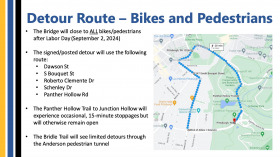- June 26th, 2024
- 0 Comments

At the most recent public meeting on June 24, 2024, City of Pittsburgh Department of Mobility and Infrastructure (DOMI) and PennDOT representatives presented the latest construction timeline, project scope, and more – including updated information related to Detour Routes for bicyclists and pedestrians that are slated to begin after Labor Day on September 2, 2024, when the bridge will close to all bikes and pedestrians (in addition to the existing vehicular restriction).
For up-to-date information about the project and a brief history, check out our Construction Resources Map here or visit the City of Pittsburgh's EngagePGH microsite dedicated to the project here.
The posted 1.4-mile detour will use the following route, adding nearly 30-minutes travel time for pedestrians walking at an average pace:
- Left on Dawson Street
- Left on S Bouquet Street
- Right on Roberto Clemente Drive
- Right on Schenley Drive
- Right on Panther Hollow Road
- Detour route ends on the opposite side of the Charles Anderson Bridge near at intersection of Panther Hollow Road and Boulevard of the Allies
When this detour is implemented, the Panther Hollow Trail to Junction Hollow will also experience occasional 15-minute stoppages as needed, but will otherwise remain open. The Bridle Trail will see limited detours through the Anderson Pedestrian Tunnel, as well.
Existing Vehicle Detour (Unchanged): Information provided at the most recent public meeting cites that the existing vehicle detour remains unchanged, directing motorists to use Bates Street from the Boulevard of the Allies, left onto Second Avenue, continuing (left) on Greenfield Avenue, left on Ronald Street and across the Greenfield Bridge to Greenfield Road, which intersects with Panther Hollow Road further west of the Bridge near Bartlett Playground and the Schneley Oval.
Background of the project: Constructed in 1939 and opened in 1940, the Charles Anderson Bridge, which is eligible for the National Register of Historic Places (NRHP) carries the Boulevard of the Allies from Oakland to Squirrel Hill and provides an entrance to Schenley Park. The City of Pittsburgh initially anticipated the need for bridge rehabilitation and began working in 2019 to develop plans and timeline, with an original target for constrution start in 2026, however, following inspection activities in 2022, the bridge was deemed unsafe and immediately closed by City officials in February 2022. At that time, the City accelerated the construction timeline by leveraging State and Federal funds, and the engineering team began collaborating with reviewers to complete two years of scheduled work in just 6 months.
In line with the original work schedule, public outreach related to this project began in Fall 2019 with meetings with focus groups and surveys of stakeholders, followed by Section 106 consulting party meetings in Fall 2021 and presentation of the preferred bridge design alternative in January 2022 before the emergency bridge closure in February 2022.
Construction timeline anticipated to span two years with construction beginning in Fall 2024 and continuing through all of 2025 to end in Fall 2026 – with a target reopening date to all traffic slated for the end of November 2026. Currently, as of Summer 2024, active work entails reviews, permitting, and off-site fabrication, which will be followed by repairs to steel truss panels and installation of work platforms in Fall 2024, at which point the Bridge will close to all traffic.
Existing Condition vs. Final Condition: Existing bridge conditions include two lanes in each direction and sidewalks on both sides. Upon completion of the Bridge Rehabilitation Project, final conditions will include two outbound travel lanes (westbound) and one inbound travel lane (eastbound), as well as a two-way cycle track on the inbound side of the bridge and widened sidewalks for pedestrians on both sides.













